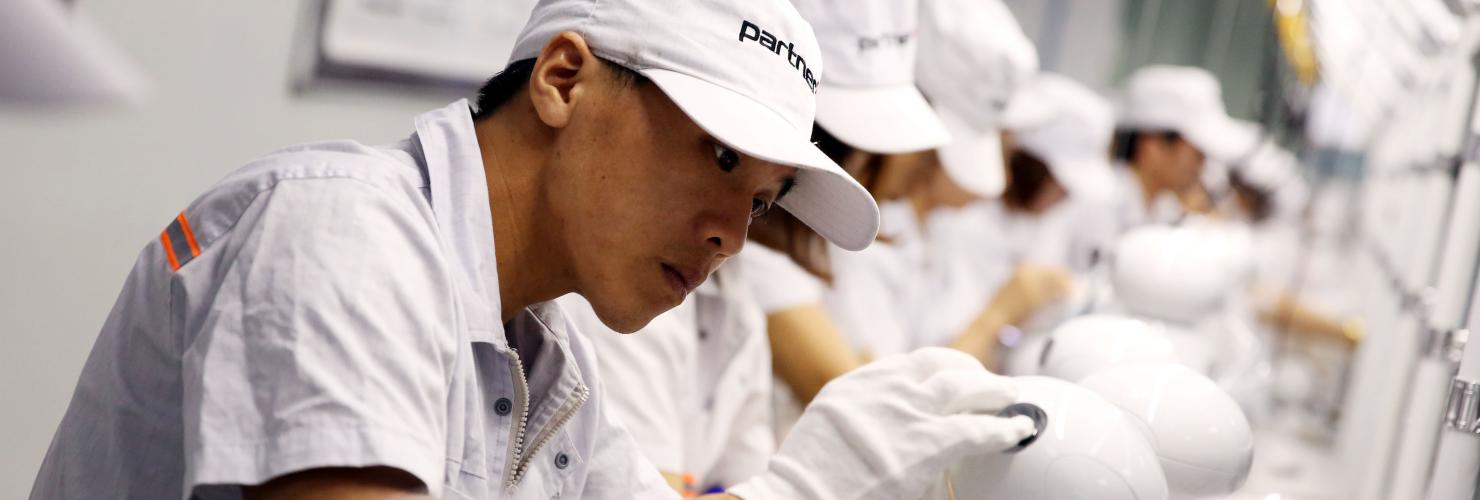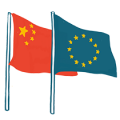

Europe needs to stand up to China’s state capitalist model
The “Made in China 2025” strategy is supposed to align the global ambitions of the government and Chinese state-owned and private companies. If innovation is driven by strategic national targets rather than by profit expectations, it represents an export of China’s state-led economic system and a challenge to the affected industries and economies of industrialized countries.
After the Trump administration imposed tariffs on Chinese goods, a full-scale trade war with China seems increasingly likely. The hawkish and unilateral approach employed by the US might be questionable, but it has its merits in that it brings to light China’s problems with its major trading partners, including the EU, which have long gone unaddressed.
Despite deteriorating relations with the US, Europe needs to be cautious about seeing China as a partner for holding up the rules-based international trade regime. In light of China’s strategic industrial policy, “Made in China 2025,” now is the time to establish a more assertive position towards China.
After 40 years of reform and opening in China, it is also time for a reality check. China is becoming a global competitor in high-tech industries. The decades-old division of labor with its western trading partners is coming to an end. China’s economic ascent resulted in a — sometimes painful — decline of labor-intensive manufacturing jobs in industrialized countries. On the other hand, consumers in industrialized countries benefited from lower prices, and western companies willing to invest in China benefited from lower production costs as well as a rapidly expanding market.
Exporting China’s state-led economic system
China’s ambitions to ramp up productivity by moving away from labor-intensive industries towards high-tech and innovation are legitimate at its current stage of economic development. As the example of the Asian Tiger economies has shown, it is also a necessary transformation in order to escape the middle-income trap, when emerging countries lose their cost advantage due to rising income levels while not being able to compete with industrialized countries in higher-valued sectors.
This is where the comparison with other successful emerging economies ends. China is the world’s second-biggest economy, and a domestic economic policy shift in China has global implications. This is even more the case as hopes that China would turn into a market-driven liberal economy in the process of reform have failed to materialize. China has subscribed to an economic system that combines firm control of the state with elements of a market economy.
The industrial policy emanating from the “Made in China 2025” strategy is a state-led effort to becoming a global tech leader. The domestic strategy is complemented by strategic acquisitions of foreign high-tech companies. This ambitious strategy, which covers 10 industries, presents a global challenge to market-based economies. “Made in China 2025” is at the core of the rising trade tensions between China and its major trading partner.
As Chinese state-owned and private companies align their global ambitions with those of the government, the strategy represents an export of China’s state-led economic system. This presents a challenge to the affected industries as well as to the economies of industrialized countries, in which innovation is driven by profit expectations rather than by strategic national targets. In more drastic terms: it represents a threat to the core of liberal democratic economic systems.
China needs to confront a reality check on the global impact of its economic agenda
China’s forceful push to close the technological gap should be a wake-up call for the EU. The current arrangement with China is based on a trade-off in accepting ownership restrictions or intellectual property violations in return for market access. But this arrangement no longer works as China’s companies are becoming more competitive domestically and internationally.
Brushing aside increasing western resistance as an attempt to prevent China’s rise is too simplistic. Instead, China needs to confront a reality check on the global impact of its economic agenda. Its policies have contributed to the build-up of domestic political pressure within its major trading partners, forcing politicians to find an adequate response.
As China pushes towards global economic leadership, the expectation seems to be that foreign countries will remain passive bystanders as China rolls out its state-led economic system on a global scale while using the leverage of its massive domestic market to keep criticism in check.
This perception was based on the soft touch China experienced over past decades when foreign governments fell all over themselves to participate in China’s economic growth miracle. Similarly, foreign companies have easily fallen in line to Beijing’s, at times trivial, demands without a fight. The lack of backbone has yielded in a persistently accommodative stance, despite China’s slow progress in addressing issues such as intellectual property rights or a more far-reaching reduction of restrictions foreign companies face.
China’s growth needs to become more inclusive, open and fair
This is not to say that China is not making progress. Recent relaxations of joint-venture requirements in the automotive industry or the financial sector are just some examples. But rather bold reform steps they are not, rather cautious adjustments. China’s leadership will argue that it wants to continue its gradual reform path based on its own domestic conditions. But this becomes problematic as its global economic agenda impacts on other countries.
Leaving these tensions unaddressed should no longer be an option for the EU. The time is ripe to re-evaluate the economic partnership with China or risk looking naive and weak in the eyes of the Chinese leadership. The EU will need to take a more assertive position and press China to concrete actions beyond the often minimal concessions in order to defend its liberal market-based economic system. This requires calling China out where it restricts foreign companies’ operations as much as a less aggressive state-led “Made in China 2025” strategy.
For the economic partnership to transform in a mutual, beneficial way, China’s growth needs to become more inclusive, open and fair. Imposing tariffs or bans by the US on China are blunt and confrontational tools, but they are also the result of perceptions that China dragging its feet in delivering on its promises.
It would be a feat for the EU if it can simultaneously defend a rules-based system within the WTO framework while getting China to make concessions towards becoming a more market driven and open economy. But this requires the gloves to come off and the toleration of some economic pain in the process. Otherwise Europe’s economy risks being steamrollered by China’s form of state capitalism and its aggressive industrial policies.
This article was first published on the Financial Times' beyondbrics blog on July 5, 2018.

